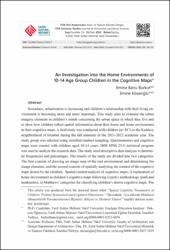| dc.contributor.author | Burkut, Emine Banu | |
| dc.contributor.author | Köseoğlu, Emine | |
| dc.date.accessioned | 2022-06-28T14:10:57Z | |
| dc.date.available | 2022-06-28T14:10:57Z | |
| dc.date.issued | 2022 | en_US |
| dc.identifier.citation | BURKUT, Emine Banu & Emine KÖSEOĞLU. "An Investigation into the Home Environments of 10-14 Age Group Children in the Cognitive Maps." FSM İlmî Araştırmalar İnsan ve Toplum Bilimleri Dergisi, 19 (2022): 369-397. | en_US |
| dc.identifier.uri | https://dergipark.org.tr/tr/pub/fsmia/issue/70588/1136517 | |
| dc.identifier.uri | https://hdl.handle.net/11352/4113 | |
| dc.description.abstract | Nowadays, urbanization is increasing and children’s relationship with their living environment is becoming more and more important. This study aims to examine the urban
imagery elements in children’s minds concerning the urban space in which they live and
to show how children reflect spatial information about their home and home environment
in their cognitive maps. A field study was conducted with children (n=387) in the Kadıkoy
neighborhood of Istanbul during the fall semester of the 2021-2022 academic year. The
study group was selected using stratified random sampling. Questionnaires and cognitive
maps were created with children aged 10-14 years. IBM SPSS 25.0 statistical program
was used to analyze the research data. The study used descriptive data analysis to determi ne frequencies and percentages. The results of the study are divided into two categories.
The first consists of drawing an image map of the real environment and determining the
image elements, and the second consists of spatially analyzing the content of the cognitive
maps drawn by the children. Spatial content analysis of cognitive maps; i) explanation of
home environment in children’s cognitive maps following Lynch’s methodology (path and
landmarks); ii) Matthews’ categories for classifying children’s drawn cognitive maps. The research findings show that i) paths are drawn more frequently as landmarks in children’s
cognitive maps, but landmarks are drawn in more detail and defined in writing. The second
finding of the study is ii) that the reflection rate of children’s functional cognitive map
drawings (elements of the built environment) from the immediate environment of their
home is quite high. This study of children’s city images and cognitive mapping abilities is
likely to give researchers in fields including city planning, architecture, educational sciences, cognitive psychology, and child psychology a new perspective. | en_US |
| dc.description.abstract | Günümüzde kentleşmenin artmasıyla birlikte çocukların yaşadıkları çevreyle kur dukları ilişkinin anlaşılması daha önemli hale gelmektedir. Bu araştırmanın amacı, çocuk ların yaşadıkları kentsel mekanla kurdukları ilişkiyi zihinlerindeki kentsel imaj öğeleri
üzerinden araştırmak, çocukların ev ve yakın çevresindeki mekansal bilgiyi bilişsel hari talarına nasıl yansıttıklarını ortaya koymaktır. Bu araştırmanın alan çalışması, 2021-2022
eğitim-öğretim yılı güz döneminde İstanbul ili Kadıkoy ilçesindeki (n=387) çocuklarla
gerçekleştirilmiştir. Çalışma grubu tabakalı örnekleme yoluyla seçilmiştir. 10-14 yaş gru bu çocuklarla anket ve bilişsel harita çizimi yapılmıştır. Araştırmanın verileri IBM SPSS
25.0 istatistik programında analiz edilmiştir. Araştırmada betimsel veri analizi yapılarak
frekans ve yüzdeler ortaya koyulmuştur. Araştırma bulguları iki başlık altında yorumlan mıştır. Birincisi kentsel mekanın imaj haritası çizilmesi ve imaj öğelerinin tespit edilmesi,
ikincisi ise çocukların çizdikleri bilişsel haritaların mekansal içerik analizinin yapılma sıdır. Bilişsel haritaların içerik analizi; i) çocukların bilişsel haritalarında ortaya çıkan
ev çevresine ait imaj öğelerinin Lynch’in metodolojisine göre (yollar ve işaret öğeleri)
değerlendirilmesi, ii) çocukların çizdikleri bilişsel haritaların Matthews’in kategorilerine
göre sınıflandırılasıdır. Araştırmanın bulgularına göre, i) çocukların bilişsel haritalarında
yol imgesinin çizimi, işaret öğesine göre daha fazla görülmesine rağmen, işaret öğeleri
daha ayrıntılı çizilmiş ve yazılı olarak tanımlanmıştır. Araştırmanın ikinci bulgusu ise
ii) çocukların evlerinin yakın çevresine ait işlevsel (yapılı çevre unsurlarını) bilişsel ha rita çizimlerine yansıtma oranının oldukça fazla olduğu görülmektedir. Çocukların kent
imajları ve bilişsel haritalama yetenekleri üzerine yapılan bu araştırmanın şehir planlama,
mimarlık, eğitim bilimleri, bilişsel psikoloji ve çocuk psikolojisi gibi alanlarda yapılacak
araştırmalara farklı bir bakış açısı sağlaması beklenmektedir. | en_US |
| dc.language.iso | eng | en_US |
| dc.publisher | FSM Vakıf Üniversitesi | en_US |
| dc.relation.isversionof | 10.16947/fsmia.1136517 | en_US |
| dc.rights | info:eu-repo/semantics/openAccess | en_US |
| dc.subject | Children | en_US |
| dc.subject | Cognitive Map | en_US |
| dc.subject | Home Environment | en_US |
| dc.subject | Urban İmage Element | en_US |
| dc.subject | Çocuk | en_US |
| dc.subject | Bilişsel Harita | en_US |
| dc.subject | Ev Çevresi | en_US |
| dc.subject | Kentsel İmaj Öğeleri | en_US |
| dc.title | An Investigation into the Home Environments of 10-14 Age Group Children in the Cognitive Maps | en_US |
| dc.title.alternative | 10-14 Yaş Grubu Çocukların Ev Çevrelerinin Bilişsel Haritalarda İncelenmesi | en_US |
| dc.type | article | en_US |
| dc.relation.journal | FSM İlmî Araştırmalar İnsan ve Toplum Bilimleri Dergisi | en_US |
| dc.contributor.department | FSM Vakıf Üniversitesi, Rektörlük, FSM İlmî Araştırmalar İnsan ve Toplum Bilimleri Dergisi | en_US |
| dc.contributor.authorID | https://orcid.org/0000-0003-0252-4054 | en_US |
| dc.contributor.authorID | https://orcid.org/0000-0003-2457-7659 | en_US |
| dc.identifier.issue | 19 | en_US |
| dc.identifier.startpage | 369 | en_US |
| dc.identifier.endpage | 397 | en_US |
| dc.relation.publicationcategory | Makale - Ulusal Hakemli Dergi - Kurum Öğretim Elemanı | en_US |
| dc.contributor.institutionauthor | Köseoğlu, Emine | |



















